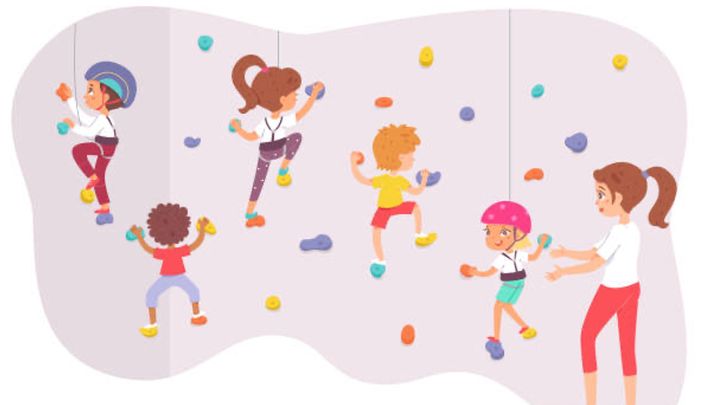(ENGLISH BELOW)
CHI SIAMO? Un gruppo di medici ed ingegneri dell’Ospedale Infantile Regina Margherita di Torino (Italia), del Politecnico di Torino e di Milano e dell’università di Torino.
COSA VOGLIAMO FARE? Predisporre una parete di arrampicata sensorizzata nella palestra dell’Ospedale Infantile Regina Margherita di Torino (Italia).
PERCHÉ? Per fornire uno strumento di riabilitazione e valutazione neuromotoria per pazienti in età compresa tra 6-16 anni con limitazioni funzionali.
CHI SONO QUESTI PAZIENTI? La Paralisi cerebrale infantile (PCI) è una malattia neuromotoria caratterizzata da un danno irreversibile del sistema nervoso centrale per cause differenti. La PCI colpisce 1/500 nati, con disordini sia cognitivi che motori di gravità diverse. Nessun intervento chirurgico potrà rendere funzionale un arto “dimenticato”, pur migliorandone la meccanica e le potenzialità motorie, se il paziente avrà escluso l’arto a livello cerebrale. Questo rende fondamentale la presa in carico precoce!
PERCHÉ L’ARRAMPICATA? La riabilitazione deve essere un momento quanto più piacevole e coinvolgente. L’attività dell’arrampicata è una delle poche in cui si è naturalmente portati ad utilizzare tutti gli arti. Migliora inoltre la coordinazione, l’equilibrio, la propriocezione, l’approccio sensoriale all’ambiente, oltre che il tono muscolare e le capacità motorie.
UNA PARETE SENSORIZZATA: Attraverso l’utilizzo di specifici sistemi di analisi del movimento, risulta possibile:
• Valutare e misurare la capacità di: raggiungere prese situate ad una distanza maggiore, caricare un arto inferiore paretico, mantenere la presa con l’arto superiore paretico, compiere un determinato circuito test in un intervallo di tempo e con una maggiore fluidità, e molto altro.
• Valutare e quantificare il miglioramento del range di movimento (ROM).
• Misurare la forza applicata su ogni presa in termini di intensità e direzione.
Studi universitari preliminari avviati tramite una collaborazione tra il Politecnico di Torino ed il Politecnico di Milano hanno consentito il design, la progettazione e lo sviluppo di sensori di forza customizzati che possono essere integrati al muro di arrampicata senza alterare la configurazione delle singole prese e di conseguenza senza alterare il movimento.
MA FUNZIONA??? Gli studi effettuati in tutto il mondo sugli effetti dell’arrampicata nei bambini e negli adolescenti hanno dimostrato miglioramenti nell'efficienza e nelle abilità motorie generali.
PERCHÉ CI SERVE UNA MANO? Chiediamo il vostro aiuto per acquistare l’attrezzatura in particolare i sensori, il muro di arrampicata e le prese e coprire alcuni dei costi come l’analisi dei dati.
A chi arrampica, che sa quanto è divertente scalare e quanto faccia bene, a chi si occupa di piccoli pazienti come caregiver o come professionista, che sa quanto sia importante farli divertire durante la riabilitazione e le visite in ospedale, a chiunque sia sensibile al tema, grazie di cuore del vostro sostegno!
Condivideremo i risultati del nostro lavoro con tutti, ed in particolare con altre equipe che volessero predisporre questo tipo di struttura nel loro ospedale o struttura riabilitativa!
Condividete la nostra campagna e aiutateci a realizzare questo bellissimo muro sensorizzato!!

---
WHO ARE WE? A group of doctors and engineers from the Regina Margherita Children’s Hospital in Turin (Italy), the Politecnico of Turin and Milan and the University of Turin.
WHAT WE WANT TO DO? Set up a sensorized climbing wall in the gym of the Regina Margherita Children’s Hospital in Turin (Italy).
WHY? To provide a tool of rehabilitation and neuromotor assessment for patients aged 6-16 years with functional limitations.
WHO ARE THESE PATIENTS? Infantile cerebral palsy (CP) is a neuromotor disease characterised by irreversible damage to the central nervous system for different causes. CPI affects 1/500 births, with both cognitive and motor disorders of varying severity. No surgery can make a "forgotten" limb functional, while improving the mechanics and motor potential, if the patient has excluded the limb at the brain level. This makes early management essential!
WHY CLIMBING? Rehabilitation should be as enjoyable and engaging as possible. The activity of climbing is one of the few in which one is naturally inclined to use all the arts. It also improves coordination, balance, proprioception, sensory approach to the environment, as well as muscle tone and motor skills.
A SENSORIZED WALL: Through the use of specific systems of motion analysis, it is possible to:
• Evaluate and measure the ability to: reach holds located at a greater distance, load a paretic lower limb, maintain the grip with the paretic upper limb, perform a given test circuit in a time interval and with greater fluidity, and much more.
• Evaluate and quantify the improvement of the movement range (ROM).
• Measure the force applied on each grip in terms of intensity and direction.
Preliminary university studies initiated through a collaboration between the Polytechnic of Turin and the Polytechnic of Milan have allowed the design and development of customized force sensors that can be integrated into the climbing wall without altering the configuration of individual holds and consequently without altering the movement.
BUT DOES IT WORK? Worldwide studies of the effects of climbing in children and adolescents have shown improvements in overall efficiency and motor skills.
WHY WE NEED HELP? We ask your help to purchase the equipment especially the sensors, and cover some of the costs such as data analysis, the wall, holds etc
To those who climb that knows how fun it is to climb and how good it is, to those who take care of small patients such as caregivers or health professionals, who know how important it is to entertain them during rehabilitation and hospital visits, to anyone who is sensitive to the topic, Thank you for your support!
We will share the results of our work with everyone, and in particular with other teams who want to set up this type of structure in their hospital or rehabilitation structure!
Share our campaign and help us realize this beautiful sensorized wall!!

Organizer and beneficiary
Ortobì ONLUS Ortobì ONLUS
Beneficiary

